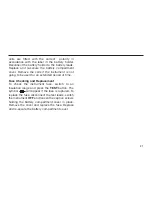
∼
7
Insulation
Tests (M
Ω
)
(See fig.1)
The insulation tests
apply a known
voltage to the circuit
under test and
measure the resulting
leakage current. The
circuit under test must
be completely
de-
energised
and
isolated
before test
connections are
made.
Insulation tests are only initiated when the
TEST
button is pressed.
1.
Set the range switch to the test voltage
required.
2.
Connect the test leads, first to the instrument,
and then to the isolated item under test.
3.
Press the
TEST
button to activate the test
voltage. Take the reading.
4. Release the
TEST
button at the end of the test.
(Press the
TEST
button if the
ltb
feature is
enabled). The last reading will hold on the display.
5. Any capacitive circuits charged during a test
will automatically discharge. If significant
voltage remains the voltage warning will occur
and the voltage present displayed.
6. Remove the test leads only when no voltage is
indicated.
Locking Test Button (ltb)
When it is desired to do a long insulation test, the
test can be ‘locked on’ by pressing the
key
while the test button is held down. The warning
will appear on the display and both buttons may be
released whilst the test continues. The next press
of the test button will terminate the test.
Note:
There is a short delay on the first operation
of ‘1000 V’ range, each time the range is selected.
This is to prevent accidental application of 1kV.
The M
Ω
range features a leakage current display.
Leakage current is the value of current that flows
during the insulation test. To view the leakage
current press the
key. To view insulation
resistance press the
key again.
FIG.1























